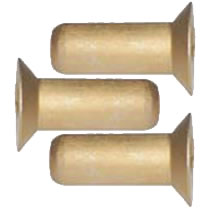
From commercial airliners and commuter jets to helicopters and space shuttles, rivets are used extensively in the aerospace industry. They are used to create permanent joints that resist vibrations and tension forces.
Traditional threaded fasteners may loosen when exposed to regular vibrations or tension forces. As permanent fasteners, though, rivets are protected from such loosening. But if you’re planning to use rivets, you should familiarize yourself with setting force.
Overview of Setting Force
Setting force is the amount force needed to install a rivet. It’s typically expressed in pounds. Different types of rivets have a different setting force. The higher the setting force, the more force you’ll have to apply — either manually or with the assistance of a tool — to install the rivet.
Rivets are designed to deform during installation, which is essentially how they create permanent joints that resist vibrations. With solid rivets, for instance, a buckling bar is placed behind the rivet and then a hammer or similar tool is used to strike the head. This striking action causes the back of the rivet to deform. The rivet’s setting force determines how much force is needed to deform the rivet without breaking the rivet or the surrounding materials.
What Affects Setting Force
Several factors will affect a rivet’s setting force. Bigger rivets typically require more force to deform and install than their smaller counterparts. The materials with which a rivet is used will also affect its setting force. If the surrounding materials are particularly hard, a greater setting force may be required.
Another factor that affects setting force is the condition of the hole. Rivets are typically installed in predrilled holes. If the hole is too small or doesn’t feature clean edges, you’ll probably have to use more force to deform and install the rivet.
The Importance of Setting Force
You should consider the setting force when installing rivets. If it’s too low, the rivet may not deform properly. Deformation, of course, is critical to the function of rivets. If a rivet doesn’t deform, it won’t be able to create a strong and secure joint.
Too much setting force, on the other hand, may damage the rivet itself or the materials around it. Damage such as this is particularly common when working with soft materials, such as plastic or aluminum.
Compression guns and similar riveting tools are designed to handle specific loads. Using too much setting force will expose these tools to premature wear and tear — or they may break altogether. You can protect your tools from unnatural wear and tear by using the right setting force.



